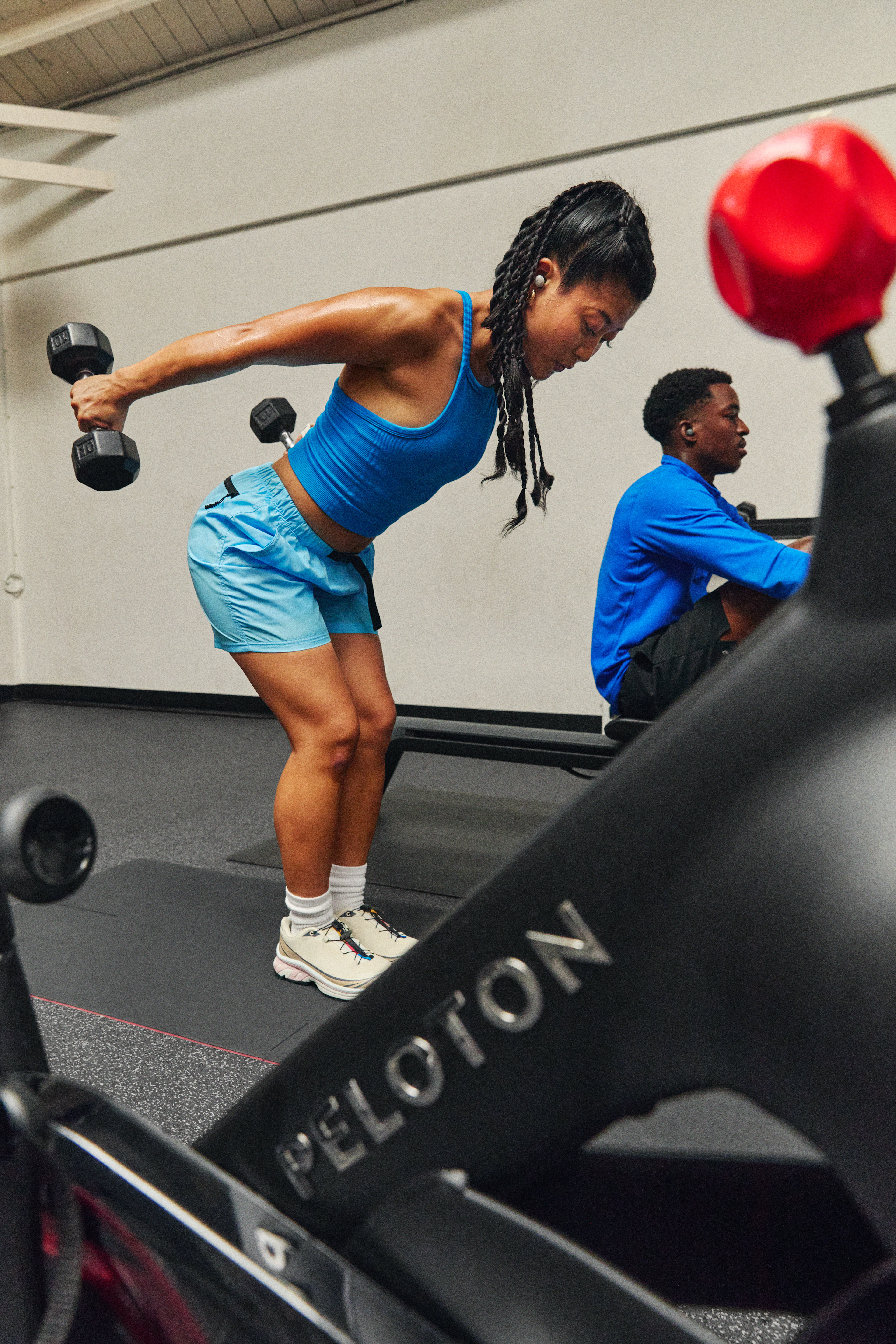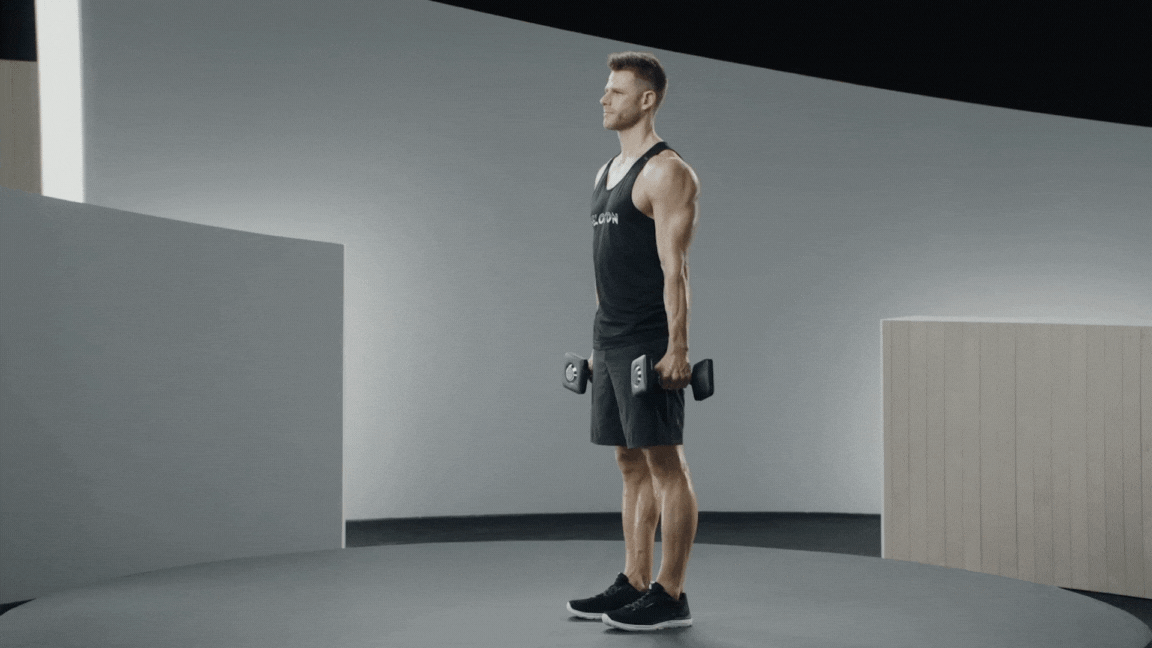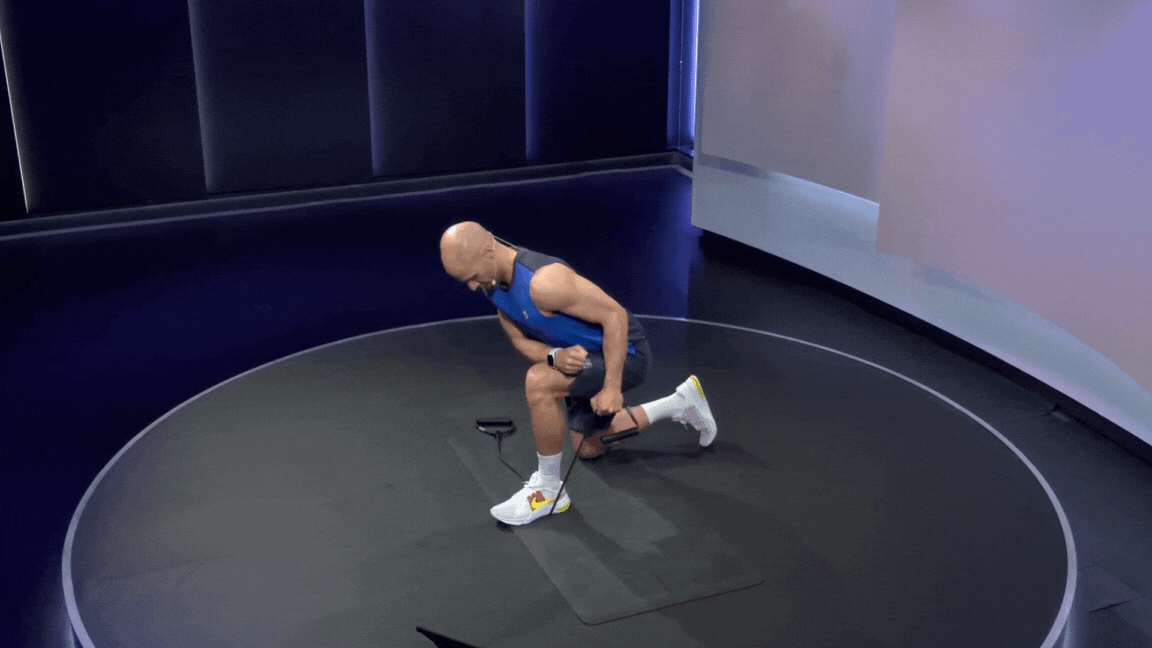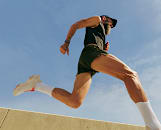
How to Do Triceps Kickbacks So You're Hitting All the Right Muscles
Small movement, big burn.
By Erin Bunch •
What Are Triceps Kickbacks?
Muscles Worked By Triceps Kickbacks
The Benefits of Doing Triceps Kickbacks
How to Do Triceps Kickbacks with Proper Form
Tips for Doing Triceps Kickback Correctly
Common Mistakes to Avoid
How to Progress Your Triceps Kickbacks
How to Add Triceps Kickbacks to Your Routine
If you’re aiming for sculpted arms but spend most of your time training your biceps, you’re overlooking an important muscle: the triceps brachii, or triceps. As the largest muscle in your arm, the triceps deserve just as much attention as your biceps—if not more.
Discover more ways to reach your goals with Peloton
Targeting the triceps isn’t just about aesthetics. This key muscle is responsible for extending the elbow joint, which allows you to straighten your arm—a fundamental movement that powers many daily activities. For example, triceps strength is necessary for everyday tasks that require pushing or lifting. The triceps also help you perform upper-body exercises like push-ups, overhead presses, and rows. Additionally, they’re essential for athletic activities that involve quick or forceful arm movements, such as swimming, playing tennis, and throwing a ball.
One effective way to target them? The triceps kickback. Triceps kickbacks are simple, effective, and easy to do just about anywhere, and all you need is a dumbbell or dumbbell-sized object to add a little weight. There are, however, important considerations to keep in mind when performing a triceps kickback. Below, Peloton instructor Matty Maggiacomo shares how to perform this exercise correctly, along with modifications, progressions, and tips for working it into your fitness routine.
What Are Triceps Kickbacks?
“Tricep kickbacks are an isolation exercise that targets the long head muscle of the triceps,” Matty says. This move starts in a hinged position with your elbow bent, then finishes with a straight-arm extension to engage the triceps. It’s typically performed with a dumbbell.

Peloton App
Access thousands of classes with no equipment needed.
Muscles Worked By Triceps Kickbacks
As the name suggests, the triceps consist of three distinct “heads,” or sections. Kickbacks primarily target the long head, which runs along the back of your upper arm and is the largest part of the muscle. However, they also work the lateral head, which is located on the outer side of the upper arm, as well as the medial head, which sits beneath the other two triceps heads.
The Benefits of Doing Triceps Kickbacks
Tricep kickbacks are a common go-to arm exercise, and for good reason: they’re simple, require minimal equipment, and start burning, fast. “Tricep kickbacks are great for improving arm definition and strength,” Matty says. They also enhance functional strength, making everyday tasks—like lifting, carrying, and pushing—easier.
For athletes, triceps kickbacks enhance performance by helping to power movements such as throwing and swimming. And kickbacks also support joint stability, especially around the elbows and shoulders, which can reduce the risk of injury. All in all, incorporating this classic move into your routine can lead to stronger arms, improved performance, and a lower risk of injury, Matty says.

How to Do Triceps Kickbacks with Proper Form
Tricep kickbacks are typically performed with dumbbells. Matty recommends choosing a weight that lets you move with control and maintain proper form throughout the exercise. Below, he breaks down how to do triceps kickbacks properly, step by step.
Stand with your feet hip-width distance apart, holding a dumbbell in each hand. With your knees softly bent, hinge forward at the hips, keeping your back straight and core engaged. Bend your elbows to 90 degrees, keeping your upper arms close to your torso, palms facing toward each other.
Exhale and extend your arms straight backward by squeezing your triceps. Keep your elbows tucked in and stationary—only your forearms should move. Pause briefly at the top of the movement when your arms are fully extended.
Inhale and slowly return to the starting position by bending your elbows back to 90 degrees. Maintain control throughout the movement to prevent swinging or momentum.
Do 3 sets of 10–12 reps to focus on endurance, or 3 sets of 8–10 reps with heavier weights to build strength.
Tips for Doing Triceps Kickback Correctly
As with any exercise, proper form is crucial for achieving optimal results and avoiding injury. Here, Matty advises on best practices for a triceps kickback.
Engage your core. Avoid arching or rounding your lower back to prevent injury or strain on the back, Matty says. To engage your core properly, think about gently drawing your belly button to your spine while contracting the sides and back of your core.
Keep your elbows close. Make sure your upper arms are right next to your torso and stay in place while only your lower arms move.
Move slowly with a focus on engagement. Move with control during both the extension and return phases so you can ensure you’re activating the right muscles.
Keep your gaze slightly forward. Don’t lift your chin to look up or lower your chin toward your chest. This helps maintain neck and spine alignment and reduces strain on the neck, Matty says.
Common Mistakes to Avoid
Tricep kickbacks may seem simple, but Matty says there are a few common mistakes he’s observed people making while performing the exercise:
Swinging the Arms: When executing a triceps kickback, Matty says it’s important not to use momentum or swing the dumbbells. “Keep the movement slow and controlled,” he says. “Focus on keeping your elbows locked and only moving your forearms.”
Breaking at the Wrist: It’s also important not to let the wrist drop or flex during the movement, says Matty. “Maintain a neutral wrist position throughout—imagine your wrist as an extension of your forearm,” he says.
Rounding the Back: If your back is rounded, Matty says it means you’re not activating all the muscles you need to be activating. “Engage your core and keep your spine neutral,” Matty says. “Avoid hinging too far forward.”
Elbows Moving Away from Torso: Try to make sure your elbows don’t drift outward, as this reduces triceps engagement, Matty says. “Keep your elbows pinned to your sides to maximize isolation, making sure that only the forearm is moving,” he adds.

How to Progress Your Triceps Kickbacks
Over time, your muscles adapt to the demands you place on them, and this can cause your progress to stall. One easy but effective way to keep your triceps kickbacks challenging is by gradually increasing the weight of your dumbbell. Here, Matty shares a few other strategies for progressing or modifying your kickbacks as needed.
Single Arm Triceps Kickback
A single arm triceps kickback is performed by engaging in the movement one arm at a time, with a focus on form and control, Matty says. Isolating one arm at a time can lead to better muscle activation. It also increases the demand on your core for stability. Matty recommends placing your non-working hand on a bench for support, but if you want to level up, performing the movement without this aid increases demand on your core.
Resistance Band Triceps Kickback
When you’re using dumbbells for triceps kickbacks, most of the effort happens at the top of the movement. A resistance band, on the other hand, maintains tension throughout the entire range—especially on the return—helping to deepen triceps engagement and enhance muscle activation. You can do a triceps kickback with a resistance band by anchoraing a band at waist height or kneeling, as demonstrated above by Peloton instructor Marcel Maurer.
Incline Bench Triceps Kickback
If you’re looking for a modification rather than a progression, Matty recommends performing your kickbacks on an incline bench. This reduces strain on the lower back by supporting your torso, allowing you to focus on the triceps without worrying about maintaining proper posture or risking lower back discomfort. The incline also changes the angle of the exercise, potentially altering the way the triceps are activated when compared to the flat bench or standing version. To perform this exercise, lie face down on an incline bench at a 45-degree angle, says Matty.
How to Add Triceps Kickbacks to Your Routine
While triceps kickbacks can be performed as a one-off exercise anytime, Matty recommends including them in your routine two to three times per week—especially as part of an upper-body, push-focused, or arm-specific workout.
To build overall arm strength, he suggests pairing triceps kickbacks with compound exercises like push-ups or bench presses, which work multiple muscle groups at once. (Tricep kickbacks, on the other hand, are an isolation exercise, as they focus on just one muscle group.) When you’re including them with compound moves, triceps kickbacks should come after the compound movement, “ideally as a finishing move to fully fatigue the triceps,” Matty says.
You can also take a superset approach by alternating exercises that hit opposing muscle groups with little to no rest in between, he says. For example, try pairing triceps kickbacks with bicep curls for a balanced, full-arm burn, Matty says.
Tricep kickbacks are safe for most, but Matty cautions that those with pre-existing elbow or shoulder injuries should proceed with caution, or even consult with a physical therapist before engaging in the exercise. “If maintaining a hinged position causes lower back discomfort, modifications such as performing the movement on an incline bench or single arm version may be safer,” he says.
To keep your triceps workouts balanced, mix in exercises like triceps push-ups, overhead presses, and dips alongside your kickbacks—and don’t forget to stretch your triceps afterward. For fully guided workouts that include triceps kickbacks, try a Peloton strength class with Matty on the Peloton App.
This content is for informational and educational purposes only and does not constitute individualized advice. It is not intended to replace professional medical evaluation, diagnosis, or treatment. Seek the advice of your physician for questions you may have regarding your health or a medical condition. If you are having a medical emergency, call your physician or 911 immediately.
Build full-body strength
Enter your email to get articles, instructor tips, and updates from Peloton sent to your inbox.
By providing your email address, you agree to receive marketing communications from Peloton.
For more about how we use your information, see our Privacy Policy.












